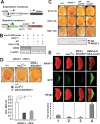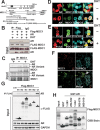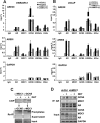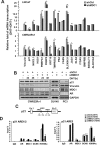MDC1 functionally identified as an androgen receptor co-activator participates in suppression of prostate cancer
- PMID: 25934801
- PMCID: PMC4446443
- DOI: 10.1093/nar/gkv394
MDC1 functionally identified as an androgen receptor co-activator participates in suppression of prostate cancer
Abstract
Mediator of DNA damage checkpoint protein 1 (MDC1) is essential for DNA damage response. However, the role of MDC1 in modulating gene transcription independently of DNA damage and the underlying mechanisms have not been fully defined. Androgen receptor (AR) is the central signaling pathway in prostate cancer (PCa) and its target genes are involved in both promotion and suppression of PCa. Here, we functionally identified MDC1 as a co-activator of AR. We demonstrate that MDC1 facilitates the association between AR and histone acetyltransferase GCN5, thereby increasing histone H3 acetylation level on cis-regulatory elements of AR target genes. MDC1 knockdown promotes PCa cells growth and migration. Moreover, depletion of MDC1 results in decreased expression of a subset of the endogenous androgen-induced target genes, including cell cycle negative regulator p21 and PCa metastasis inhibitor Vinculin, in AR positive PCa cell lines. Finally, the expression of MDC1 and p21 correlates negatively with aggressive phenotype of clinical PCa. These studies suggest that MDC1 as an epigenetic modifier regulates AR transcriptional activity and MDC1 may function as a tumor suppressor of PCa, and provide new insight into co-factor-AR-signaling pathway mechanism and a better understanding of the function of MDC1 on PCa.
© The Author(s) 2015. Published by Oxford University Press on behalf of Nucleic Acids Research.
Figures







Similar articles
-
The tumor suppressor ING1b is a novel corepressor for the androgen receptor and induces cellular senescence in prostate cancer cells.J Mol Cell Biol. 2016 Jun;8(3):207-20. doi: 10.1093/jmcb/mjw007. Epub 2016 Mar 18. J Mol Cell Biol. 2016. PMID: 26993046
-
Inhibition of MAPK-signaling pathway promotes the interaction of the corepressor SMRT with the human androgen receptor and mediates repression of prostate cancer cell growth in the presence of antiandrogens.J Mol Endocrinol. 2009 May;42(5):429-35. doi: 10.1677/JME-08-0084. Epub 2009 Feb 17. J Mol Endocrinol. 2009. PMID: 19223455
-
Determinants of Gli2 co-activation of wildtype and naturally truncated androgen receptors.Prostate. 2014 Oct;74(14):1400-10. doi: 10.1002/pros.22855. Epub 2014 Aug 11. Prostate. 2014. PMID: 25132524
-
Identification and characterization of androgen receptor associated coregulators in prostate cancer cells.J Biol Regul Homeost Agents. 2001 Apr-Jun;15(2):123-9. J Biol Regul Homeost Agents. 2001. PMID: 11501969 Review.
-
Androgen receptor and caveolin-1 in prostate cancer.IUBMB Life. 2009 Oct;61(10):961-70. doi: 10.1002/iub.244. IUBMB Life. 2009. PMID: 19787702 Review.
Cited by
-
Androgen receptor contributes to repairing DNA damage induced by inflammation and oxidative stress in prostate cancer.Turk J Biol. 2023 Oct 11;47(5):325-335. doi: 10.55730/1300-0152.2667. eCollection 2023. Turk J Biol. 2023. PMID: 38155939 Free PMC article.
-
BAP18 coactivates androgen receptor action and promotes prostate cancer progression.Nucleic Acids Res. 2016 Sep 30;44(17):8112-28. doi: 10.1093/nar/gkw472. Epub 2016 May 25. Nucleic Acids Res. 2016. PMID: 27226492 Free PMC article.
-
MYSM1 acts as a novel co-activator of ERα to confer antiestrogen resistance in breast cancer.EMBO Mol Med. 2024 Jan;16(1):10-39. doi: 10.1038/s44321-023-00003-z. Epub 2023 Dec 15. EMBO Mol Med. 2024. PMID: 38177530 Free PMC article.
-
Multiomics approach to profiling Sertoli cell maturation during development of the spermatogonial stem cell niche.Mol Hum Reprod. 2023 Feb 28;29(3):gaad004. doi: 10.1093/molehr/gaad004. Mol Hum Reprod. 2023. PMID: 36688722 Free PMC article.
-
ASH2L is involved in promotion of endometrial cancer progression via upregulation of PAX2 transcription.Cancer Sci. 2020 Jun;111(6):2062-2077. doi: 10.1111/cas.14413. Epub 2020 May 23. Cancer Sci. 2020. PMID: 32279431 Free PMC article.
References
Publication types
MeSH terms
Substances
LinkOut - more resources
Full Text Sources
Other Literature Sources
Medical
Molecular Biology Databases
Research Materials
Miscellaneous

